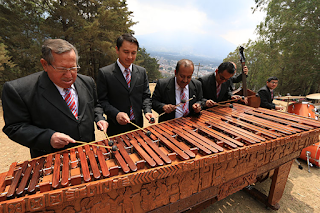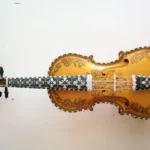
The marimba is a percussion instrument that looks similar to the xylophone but is larger in size. It differs from the xylophone in that it has a wider compass and lower register, as well as resonators. The marimba’s wood bars are thinner than those of a xylophone. As a result, the sound becomes deeper and darker. The marimba did not become popular among musicians and composers until the 1950s, but it has since surpassed the xylophone in a variety of musical applications. Earlier versions of the marimba date back centuries to Latin America and African slaves, but the current version used in orchestras and modern music was adapted from the earlier designs in the 1900s in Europe and the United States.
The term “marimba” comes from the Bantu language spoken in Mozambique and Malawi. The word’ma’ means ‘a large number of objects,’ and the word ‘rimba’ means ‘a single-bar xylophone.’
A marimba player or a marimbist is a musician who plays the marimba.
In some countries, the word “phone” is added to the word “marimba,” and the instrument is referred to as a marimbaphone.
The marimba’s frame is usually made of metal, but in some cases it is made of wood. The frame is supported by wheels.
The marimba has two rows of wood bars, usually spaced about 4cm apart in height.
The marimba’s bars are made of wood and are arranged on the frame in accordance with their size. The wood bars have holes drilled in one end to allow string to be threaded through to secure the bars.
The marimba’s bars rest on pegs mounted on the frame, allowing them to vibrate when struck with the mallet.
The number of bars used to make a marimba is determined by the range.
Rosewood is a popular material for marimba bars. If the marimba bar is too hard, it can be broken with a mallet.
The pitch of the bars on a marimba is determined by the length, thickness, and density of the bar. When struck, the width has no effect on the pitch of the bar.
When tuning an instrument quickly, a lump of wax can be added to a bar. Other methods of tuning include adding or removing wood or other material. In some cases, filing material off the end of the bar is required to produce the correct pitch.
The mallet used to play the marimba is different depending on the sound desired. The marimba mallets are classified according to their hardness: hard, medium, or soft. Mallet heads are typically made of rubber, plastic, or wood. Typically, they are wrapped in yarn.
Jazz, ensembles, concertos, marching bands, bugle and drum corps, orchestras, and Latin music all make use of marimbas.
The marimba was played by Brian Jones in the Rolling Stones’ songs Out of Time and Under My Thumb.
5 FAQs about Marimba:
- What is a marimba and what does it sound like?
The marimba is a beautiful-sounding percussion instrument belonging to the mallet percussion family. It consists of graduated wooden bars suspended over resonators that amplify the sound. These bars are struck with mallets to produce rich, warm tones that range from low and mellow to high and bright. The marimba’s sound is often described as clear, vibrant, and even mesmerizing.
- What kind of music is played on the marimba?
The marimba is a versatile instrument used in a wide range of musical styles. Here are some common examples:
- Classical music: A significant repertoire of solo and ensemble pieces has been written specifically for the marimba. These pieces showcase the instrument’s technical capabilities and expressive range.
- Marimba ensembles: Groups dedicated entirely to marimba music have become increasingly popular. These ensembles create a unique and captivating sound by combining multiple marimbas of different sizes.
- Jazz and popular music: The marimba’s warm tones and rhythmic possibilities make it a welcome addition to jazz, pop, and even rock music. It can add a touch of sophistication or a playful element to various musical arrangements.
- World music: The marimba plays a vital role in traditional music from various cultures, particularly in Central and South America. Its sound blends seamlessly with other instruments to create unique regional styles.
- How difficult is it to learn the marimba?
Learning the marimba requires dedication and practice, like any musical instrument. However, the initial steps can be manageable with proper guidance. The basic skills involve proper mallet technique, coordination between hands, and music reading. As you progress, the challenges increase with more complex rhythms and melodies.
- What are the different types of marimbas?
Marimbas come in various sizes, with the most common being:
- Soprano marimba: This is the smallest and highest-pitched marimba, with a bright and lively sound.
- Alto marimba: Slightly larger than the soprano, the alto marimba offers a wider range and a warmer tone.
- Tenor marimba: This mid-range marimba provides a rich and balanced sound, suitable for both solo and ensemble playing.
- Bass marimba: The largest and lowest-pitched marimba, the bass marimba adds a deep and powerful foundation to marimba ensembles.
There are also chromatic marimbas that include all the half-steps, unlike the standard diatonic marimbas with only the natural notes.
- How do I care for a marimba?
Proper care is essential to ensure your marimba sounds its best and lasts for years. Here are some key points:
- Temperature and humidity: Maintain a stable temperature and humidity level to prevent the wooden bars from warping or cracking.
- Cleaning: Regularly wipe down the bars with a soft, damp cloth to remove dust and fingerprints.
- Mallets: Use appropriate mallets for the marimba’s size and your playing style. Worn-out mallets can damage the bars.
- Storage: When not in use, store the marimba in a safe place away from direct sunlight and extreme temperatures. A padded case is ideal for additional protection.









